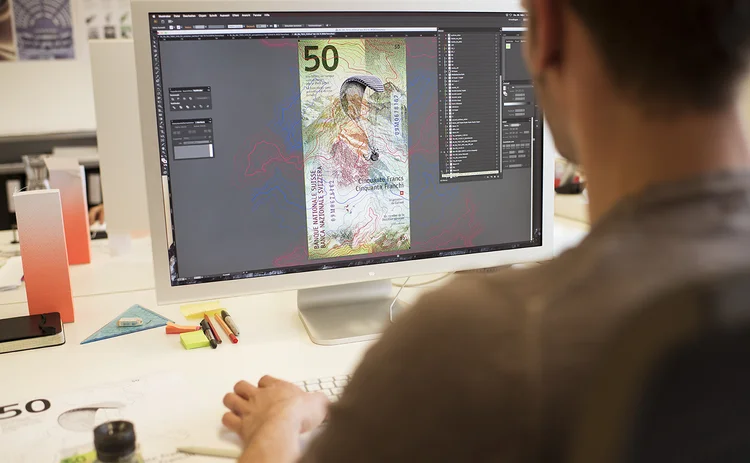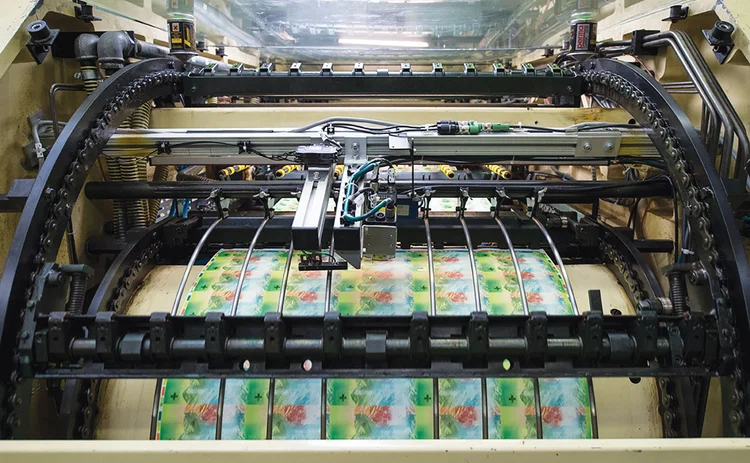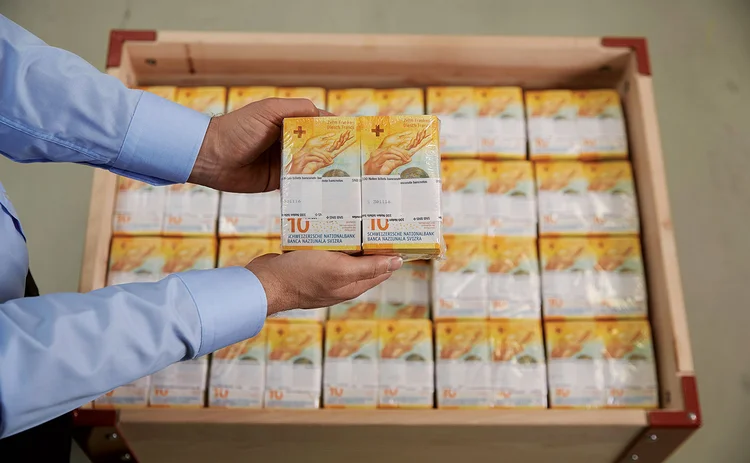
Banknote and currency services provider of the year: Landqart
Hybrid substrate provider offers banknote issuers a ‘Swiss finish’

When the Reserve Bank of Australia introduced its new polymer banknote series in 1996, it triggered a near-20-year debate about the relative merits of paper versus polymer. While paper (cotton) offered a wider range of security features, and was familiar with consumers, polymer gave central banks increased durability and a more secure substrate.
That debate changed in 2012 when Swiss banknote provider Landqart introduced Durasafe – banknotes that combine two outer layers of cotton with a central core of transparent polymer.
Landqart’s notes offer security appeal to some of the most safety-conscious banknote providers, including the Swiss National Bank. “Security-wise, it is nearly impossible to split the note, which makes it very difficult to counterfeit,” says Beat Grossenbacher, director of cash for the SNB, which started printing notes on Durasafe in 2016.
The cotton paper layers in Durasafe incorporate well-known features such as watermarks, security fibres, threads and other traditional security elements – the first line of defence against counterfeits.
While important, the cotton paper also ensures the finished banknotes retain the special tactility and feel that is characteristic of paper notes, and is immediately recognised by the public. “Durasafe banknotes can be as simple or as complex as [customers] wish, but the finished product will always retain the fundamental characteristics that they have relied on for so long,” says Axel Wappler, chief executive of Landqart.
Its likeness to the traditional cotton substrate was a key factor in the Bank of Morocco’s decision to print its MAD25 ($2.66) commemorative banknote on the substrate. “Durasafe attracted the central bank’s attention thanks to its printability, which is comparable to that of traditional banknote paper, and its excellent mechanical properties, which should confer a longer lifetime on the banknote,” a spokesperson from the bank tells Central Banking.

Cashiers and cash-handling professionals also benefit from this continuity, but in addition they receive a more robust substrate, which will perform well in cash-handling machinery for a longer period of time. “It’s slightly thicker, but not sufficient enough to warrant changes in machines or for cash handlers,” says Wappler.
Improved security
The original concept for Durasafe was to find a way of integrating clear windows into a paper banknote in a way that allowed them to be located anywhere on the note – Durasafe’s polymer core made this possible. Clear see-through windows (dubbed Thrusafe) can be positioned anywhere on the banknote, creating a feature that is instantly recognisable.
“[Landqart] have invested in the development of products customised for the use of central banks,” says Derek Rolle, deputy governor at the Central Bank of the Bahamas.
We do everything we can to integrate the security features [that customers] want as much as possible. If, for some reason, we can’t include everything, we have an open dialogue to come up with a viable alternative
Axel Wappler, Landqart
The multi-layer structure also makes it possible to have windows in just one of the paper layers (called Viewsafe), something that can be used to highlight the watermark, or to create innovative shapes through which to see the security thread.
These security benefits have resonated with central banks looking to replace high-denomination notes, which are often the most at risk of counterfeiting, despite being the least circulated. “We do everything we can to integrate the security features [that customers] want as much as possible. If, for some reason, we can’t include everything, we have an open dialogue to come up with a viable alternative,” says Wappler.
One central bank that used the new product in its early years was the National Bank of Kazakhstan. “The new banknote is the most highly protected banknote of the current series, and also one of the most secure in the world,” says Mendybai Alin, chief designer at Kazakhstan’s central bank.
Trusted partnership
What arguably makes Durasafe the best of both worlds is the ease with which it can be integrated into a family of notes – and the familiarity it offers all the stakeholders in the cash cycle.
Switzerland’s ninth banknote series will be the first banknote series to be issued entirely on the hybrid substrate. When choosing a suitable substrate, the SNB looked to move away from paper, but wanted to maintain the variety of security features available to them that are yet unavailable on polymer. Durasafe offered the perfect solution.
“We weren’t limited to the security features available to polymer, of which there are fewer possibilities,” says the SNB’s Grossenbacher. “The hybrid also means we could include 15 different security features in one note, combining the advantages of the polymer and paper substrates.”
Landqart’s long-standing relations with the SNB also helped. “We needed a partner we could trust, and we have worked with Landqart – with their paper solution – since the 1970s, so it was a natural choice for us,” explains Grossenbacher. The relationship is so deep that the SNB took a majority stake in Landqart in December 2017.
New levels of design
Banknote design has also been elevated to another level with Durasafe. Landqart’s hybrid allows for the outer layers of paper to be coloured differently. “This is a unique characteristic of this banknote,” says Kazakhstan’s Alin. “It is helpful for the general public, as you cannot confuse this banknote with another. It is also important for security, as it is not easy to counterfeit such an effect.”

Muriel Schuler, product manager at Landqart, tells Central Banking the grey paper layer is exposed to view on the front of the banknote through the half-window in the white paper and the white paper layer is visible from the back of the note through the half-window in the grey paper layer.
“You can also print on or emboss the transparent window – these are the security features that are associated with the Durasafe substrate,” she says.
Landqart admits the solution is slightly more expensive than other substrates on the market, but central banks that have adopted the hybrid believe the enhanced security is worth the investment.
“The substrate is more expensive … Its sandwiched properties, however, make it amenable to a number of top-tier security features,” says Rolle of the Central Bank of the Bahamas.
End of the lifecycle
One of the biggest challenges Landqart has had to overcome was efficiently dealing with notes taken out of circulation. While polymer notes can be broken down and recycled, Durasafe notes need to be separated before the components can be reused.
Extensive testing and real-life experience have shown the notes can be shredded using on- and offline systems with little to no trouble, the supplier claims. “The type of polymer used in Durasafe means that the shredder blades do not ‘gum up’ in operation,” says Richard Perera, Landqart’s director of marketing services.
In fact, the fusion of polymer and paper means there is less dust generated when shredding the notes, and the relatively small quantity of polymer used in the notes allows the waste to be briquetted in the same way as cotton banknotes.
The Central Banking Awards were written by Christopher Jeffery, Daniel Hinge, Dan Hardie, Rachael King, Victor Mendez-Barreira, Iris Yeung, Joel Clark and Tristan Carlyle
Only users who have a paid subscription or are part of a corporate subscription are able to print or copy content.
To access these options, along with all other subscription benefits, please contact info@centralbanking.com or view our subscription options here: subscriptions.centralbanking.com/subscribe
You are currently unable to print this content. Please contact info@centralbanking.com to find out more.
You are currently unable to copy this content. Please contact info@centralbanking.com to find out more.
Copyright Infopro Digital Limited. All rights reserved.
As outlined in our terms and conditions, https://www.infopro-digital.com/terms-and-conditions/subscriptions/ (point 2.4), printing is limited to a single copy.
If you would like to purchase additional rights please email info@centralbanking.com test test test
Copyright Infopro Digital Limited. All rights reserved.
You may share this content using our article tools. As outlined in our terms and conditions, https://www.infopro-digital.com/terms-and-conditions/subscriptions/ (clause 2.4), an Authorised User may only make one copy of the materials for their own personal use. You must also comply with the restrictions in clause 2.5.
If you would like to purchase additional rights please email info@centralbanking.com test test test




